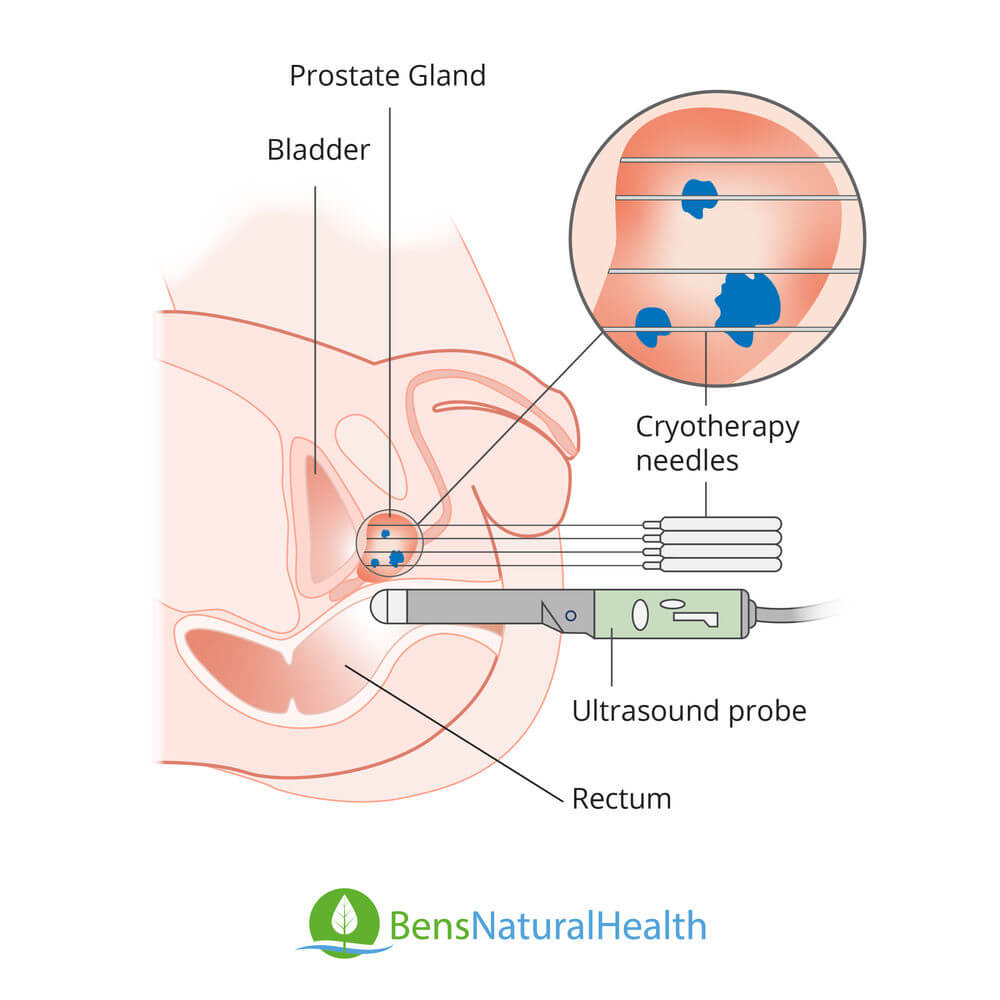- What is cryotherapy for prostate cancer?
- What happens during cryotherapy for prostate cancer?
- Why would you need to undergo cryotherapy?
- Risks of cryotherapy for prostate cancer
- What are the cons of cryotherapy for prostate cancer?
- How does cryotherapy affect the body?
- What happens after cryotherapy for prostate cancer
- Recovering from cryotherapy
- Conclusion
Cryotherapy is now widely used to treat prostate cancer.
It is minimally invasive and carries a reduced risk of complications compared to surgical approaches.
Men treated with cryotherapy experience shorter recovery time compared to those treated by surgical methods. However, it carries a risk of progressive urinary and sexual complications.
What is cryotherapy for prostate cancer?
Cryotherapy (or cryoablation) involves infusing freezing liquid (liquid nitrogen or argon gas) into the prostate gland to freeze and destroy cancer cells. Freezing liquids used in cryotherapy instantly freezes and destroys cancer cells upon contact.
Cryotherapy treats numerous types of cancer and non-malignant diseases. For prostate cancer, most doctors use it as second-line therapy following treatment relapse. It provides a safe localized treatment alternative to invasive surgery on the prostate gland and other organs. Further, it is useful for destroying residual tumors after other treatment methods fail.
Get Your FREE PSA Lowering Diet Plan!
- Naturally lower PSA levels
- Reduce nighttime trips to the bathroom
- Enjoy better bladder control and urine flow
What happens during cryotherapy for prostate cancer?
A surgeon will perform cryotherapy treatment in the hospital under general anesthesia, or local inhibition of sensation. As stated, the surgeon inserts an ultrasound probe, urinary catheter, and thin metal tubes through the rectum, urethra, or the perineum, respectively.
The ultrasound probe helps the doctor to monitor the placement of the other tubes. While the catheter is used to transport urine as well as keep the urethra warm to avoid cold damage during the procedure. The freezing liquid is circulated through thin metal probes inserted between the scrotum and the anus (perineum).
You are likely to go home on the same day as your procedure, but the catheter may stay in place in the first two weeks of healing. You may experience temporary soreness and bladder problems.

Why would you need to undergo cryotherapy?
Your doctor may recommend cryotherapy as a first treatment if you have localized prostate cancer with a low or medium risk of disease progression.
Sometimes cryotherapy is an option in the early stages of advanced prostate cancer when cancer has not spread to distant parts of the body. It is also an option for treating recurred localized prostate cancer after treatment with radiotherapy or brachytherapy.
Like many localized treatment options for prostate cancer, it is not a good salvage treatment option for metastatic disease. Similarly, cryotherapy is not an option for advanced prostate cancer.
Risks of cryotherapy for prostate cancer
What kinds of patients would be at a higher risk for complications from cryotherapy for prostate cancer?
Some factors may increase the severity of cryotherapy related side effects. In particular, when there is existing tissue damage around the prostate area. Men who have received radiotherapy may get severe side effects compared to those who get it as the first treatment.
Further, men with existing urethra and bladder problems have an increased risk of developing severe urinary complications after cryotherapy. However, few long-term studies exist on cryotherapy for treating prostate cancer. Future studies will be essential to identify potential interacting risk factors.
Generally, suitability for cryotherapy not only depends on the stage of prostate cancer but also your other clinical characteristics. The doctor will also consider the severity of current urinary symptoms and suitability for anesthetic. Unfortunately, cryotherapy for prostate cancer is relatively new, and with poorly defined long-term outcomes.
What are the cons of cryotherapy for prostate cancer?
Cryotherapy for prostate cancer treatment freezes cancer cells. Though it is minimally invasive, the cold temperature may affect healthy surrounding tissues. It has risks that require careful consideration before undergoing the procedure. You may experience varying levels of urinary problems and sexual complications.
Common side effects
- Erectile dysfunction is the most common side effect of cryotherapy mediated through nerve damage. It will cause most men to experience some decline in sexual function, including difficulty having and maintaining an erection. Studies show that the proportion of patients developing erectile dysfunction may increase over time. This suggests that the effects of cryotherapy on erectile function may be progressive (Roberts et al., 2011).
- Reduced bladder control and other urinary complications.
- Reduced bone strength: lower testosterone can thin your bones, increasing the risk of broken bones.
- Infection and inflammation may develop in the treated area. Rarely, the infection may affect the pubic bone.
- Pain and swelling of the scrotum and penis.
- Rarely, cryotherapy may cause injury to the rectum or blockage of the urethra.
How do you know you should consider other therapies for prostate cancer over cryotherapy?
Overall, certain post-cryotherapy complications are modest, however lower urinary tract complications and erectile dysfunction may be long-term. It would help if you discussed your circumstances with your doctor to identify an effective treatment option.
How does cryotherapy affect the body?
The intense cold-induced by cryotherapy also destroys most of the prostate gland. Both healthy and cancerous tissues cannot withstand extreme cold because of cold-induced cell death.
This therapy elicits four critical mechanisms of cell death, including;
- Freezing-induced programmed cell death.
- Water loss and cell shrinkage leading to membrane rupture.
- Immediate accumulation of ice crystals that rupture the cell membranes.
- Inhibition of cell metabolism and subsequent cell death.
- In addition to destroying cancer cells, the induction of these mechanisms in healthy cells underlies the side effects of cryotherapy.
After the tissue is destroyed, the immune cells clean up cell debris and any surviving cancer cells, unlike surgical approaches, less invasive, causing fewer wound healing complications. Generally, patients treated with cryotherapy experience less pain and a shorter recovery time. But it may not be a good option for you, especially if you have a large prostate gland.
How safe is cryotherapy?
Many factors modulate the outcome of treatments for prostate cancer. Several studies show that high cryotherapy levels of lower urinary tract obstruction (Roberts et al., 2011). While some of the complications are minor, sexual difficulties may reduce your quality of life.
However, patient comorbidities and clinical characteristics of the malignancy are not influenced by the occurrence of these complications.
What happens after cryotherapy for prostate cancer
What are the next steps in managing prostate cancer after undergoing cryotherapy?
Cryotherapy to treat prostate cancer may leave some cancer behind.
Lifestyle changes and natural supplements may help improve treatment outcomes and reduce the associated side effects. Aim to maintain a healthy prostate, reduce prostate inflammation, and the risk of developing new prostate conditions. A healthy diet, physical activity, and antioxidants are natural ways to reduce your risk of cancer recurrence.
Recovering from cryotherapy
Take things easy
You may be tempted to continue normal activities after one week, but this can hinder your recovery. Take things easy at least a month, avoiding lifting or moving an object.
Mild Exercise
Mild exercise can improve your blood flow and reduce the risk of a blood clot.
Avoid alcohol
Fluids: You can enhance urine flow by drinking plenty of fluids, majorly water, and tea. Try to avoid alcohol consumption as it can impair the wound healing process.
Adhere to discharge information
Your medical team will tell you the best time to return to work, start driving, or start having sex following your surgery. It is better to follow their guidance and only resume these activities when you are fully recovered to avoid complications.
Conclusion
Before choosing any treatment to treat prostate cancer, it is worth investigating all options.
All prostate treatments carry side effects, and one should choose a procedure where the side effects are less life-altering.
Boosting nutrient levels can reduce the risk of BPH and its progression. In cases of high risk of cancer progression and treatment relapse, surgical intervention may be necessary. We generally are against any invasive surgery, but we also think our readers should be informed.
Keeping your prostate healthy is the best way to reduce your risk of developing BPH. Regular physical activity and healthy diets can help reduce the risk of developing this disease or manage the symptoms.







